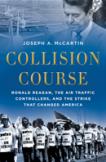Union Flight
The Great Recession—with its consequent sudden collapse in tax receipts—has inspired a fierce nationwide dispute over the rights and duties of public employees. Gov. Chris Christie of New Jersey has earned a certain folk hero status on YouTube with his verbal confrontations with state workers; Wisconsin’s Gov. Scott Walker successfully pressed an initiative to strip state workers of most collective bargaining rights and now faces a recall election as a result. Academics are engaged in a spirited debate over whether government workers are overpaid or underpaid relative to their private-sector counterparts, and federal workers have seen their pay frozen for two years running.
It is an especially opportune time for the appearance of Collision Course: Ronald Reagan, the Air Traffic Controllers, and the Strike That Changed America. In this book Joseph McCartin, a professor of history at Georgetown University, looks back to the origins, course and consequences of the strike by the Professional Air Traffic Controllers’ Organization 30 years ago and shows how a relatively small union of air traffic controllers helped shaped the destiny of organized labor for decades thereafter.
The book is a well-crafted narrative history. The strike was set in motion, McCartin contends, well before Reagan’s election and even before Patco itself was established—the elements were built into President John F. Kennedy’s 1962 executive order granting federal workers the bargain collectively. “Kennedy…issued an executive order intended to placate his labor allies while ensuring that the advent of collective bargaining in the federal service would alter existing labor relations as little as possible,” McCartin explains. “No federal workers were quicker than air traffic controllers to seize the opportunity to organize afforded by [the executive order]. And none were quicker to discover the order’s inadequacies.”
In the 1930s, 40s and 50s, millions of private-sector workers had rushed to join labor unions and bargain with their employers under the terms established in the 1935 National Labor Relations Act, or Wagner Act. But the N.L.R.A. excluded public-sector employees, and Kennedy’s executive order lacked two vital elements of the Wagner industrial relations system. First, wages and benefits were excluded from the scope of bargaining, confining contract negotiations to peripheral matters. Second, even if workers and their unions could bargain over wages and benefits, they had no mechanism for resolving an impasse. They could neither strike nor demand binding arbitration.
The air traffic controllers formed Patco in 1968 and almost instantly began to bump against the limits of this odd system of labor relations. As the endemic inflation of the 1970s swallowed up any wage increases offered by the federal government, the controllers who saw their real wages declining demanded action. They tried lobbying; they tried sickouts; they tried creative job actions where by meticulously following the F.A.A. regulation they slowed air traffic to a crawl; they tried arcane reclassifications within the civil service system. By decade’s end the controllers had elected a militant new leadership and were quietly preparing to strike.
Interestingly, both the union and the newly elected president took a number of significant steps in the hope of avoiding a confrontation. Ronald Reagan, a former president of the Screen Actors Guild, had set out not to break Patco but to coopt it; the air traffic controllers, largely military veterans, were the prototypical Reagan Democrats. Patco in turn had defied most of the labor movement by endorsing Reagan in hopes of an acceptable wage settlement. In fact, the new administration showed more flexibility at the bargaining table than Johnson, Nixon, Ford or Carter ever had. But it was too late. Patco members, who had seen their hopes disappointed too many times before, would not settle short of a major breakthrough, and in August 1981 as many as three quarters of the air traffic controllers walked off the job.
Patco had done an excellent job organizing the strike—air traffic would not be restored to prestrike levels for years—but little or nothing to justify its cause before the public or even other labor unions. When the president declared that the strike was illegal and that any controller who failed to report for duty within 48 hours would be fired, he gained the advantage in public opinion, which he never forfeited. “As president of my own union, I led the first strike ever called by that union,” Reagan explained that first day. “But we cannot compare labor-management relations in the private sector with government.” The air traffic controllers were not employed by a private interest but by the elected government; they had sworn an oath not to strike; they were violating the laws of the land, which he himself was charged to execute. Despite immense costs for the government and the American economy, Reagan never wavered, and the former union president earned a place in U.S. history as the most notable strikebreaker of the postwar era.
Whatever the president’s intentions, private-sector workers soon became collateral damage of the Patco strike. For decades, firms that valued their reputation had refrained from permanently replacing striking workers, fearing the social consequences. The Fortune 500 chief executive officers watching events unfold were neither historians nor political scientists, and they cared nothing for the distinction between private workers and public servants. What they learned was that the public backlash for breaking a strike would be muted and fleeting. As firms like Phelps Dodge, Greyhound and International Paper imitated Reagan’s “leadership,” workers learned to their sorrow that the code of honor that governed postwar labor relations no longer applied and that every job action could be their last. In that sense, more than perhaps any other, it was indeed a strike that changed America.
This article also appeared in print, under the headline “Union Flight,” in the April 9, 2012, issue.








